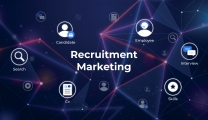5 steps to hiring more diverse candidates
Step 1: Conduct a diversity employment review
Survey your current recruiting technique and distinguish any possible blockages and disparities. For example, is it a top-of-the-pipe issue? Or is it a spilling pipeline issue?
Until you investigate your diversity employment data, you can’t get a precise image of how to improve your recruiting process.
Step 2: Pick a point to focus on
Chalking out how to re-design your inclusive recruiting methods for the better can be an overwhelming task to handle. So, the most feasible and effective approach is to pick one aspect to work on extensively.
Break down your long-term diversity goals into immediate achievable targets. For example:
Increase the level of qualified female candidates by 10% within half a year
Increase the level of qualified minorities in the upcoming quarter by 15%

Step 3: Change your candidate sourcing strategy
If your talent acquisition review reflects that you’re failing to tap into a diverse group of people, here are a few things you can do:
1. Write your job descriptions in a more inclusive manner
Make sure your job descriptions are inclusive, free from biased and non-inclusive language, and place a primary focus on the essential skills and qualifications required for the open roles.
Use gender-neutral terms in your job postings and avoid listing insignificant criteria that may exclude qualified candidates from underrepresented groups.
Master crafting job descriptions in 9 steps [+ 5 free templates]
2. Show off your client’s diverse employer brand
As a recruiter, you are in a position to guide your client to showcase their diverse employer brand. Suggest them to promote it by featuring employees from various backgrounds, ethnicity, and demographics on their website, job boards, and social media platforms.
Also, help them share success stories and highlight diversity initiatives and employee resource groups. This attracts diverse talent, builds trust, and showcases commitment to an inclusive work environment.
Make sure you also highlight their culture and brand while promoting job openings.
3. Put emphasis on flexibility
If your client offers options for remote work, flexible schedules, and alternative work arrangements, ensure you highlight this in job ads and interviews.
Work flexibility accommodates various lifestyles, caregiving responsibilities, and personal circumstances, empowering employees to achieve work-life balance, boost productivity, and enhance job satisfaction. So a ton of light should be shone on this.
4. Encourage references from minority workers
Encourage referrals from minority workers to broaden your candidate pool. Emphasize the value of their recommendations and actively seek their input.
By accepting diverse employee referrals, you tap into a wider range of viewpoints and experiences while also respecting existing diverse employee groups.
Step 4: Incorporate diversity while applicant screening and shortlisting
In the event that your diversity employment review uncovers that you have a spilling pipeline at your competitor screening, there are a couple of incredible strategies you can attempt:
Strategy 1: Blind hiring
Adopt blind hiring practices to promote diversity and mitigate biases. Remove information such as names, gender, or background from initial candidate evaluations to shift the focus to skills, qualifications, and experience.
By implementing blind hiring, you ensure fair assessment based on merit. It puts the spotlight on abilities, fostering equal opportunities and building a diverse and inclusive workforce.
Strategy 2: The “two in the pool” impact
A study highlighted in Harvard Business Review found that when the last candidate pool has just a single minority candidate, the person has basically no odds of being employed.
On the other hand, if there are, at any rate, two under-represented potential candidates in the last candidate pool, the chances of recruiting a female applicant are multiple times more prominent.
Strategy 3: Shortlisting via an applicant tracking system (ATS)
Automated and quick shortlisting via an applicant tracking system expands the variety of selected candidate resumes by replacing something as bias-prone as manual shortlisting.
In contrast to humans with their unconscious bias at play, an ATS leverages a form of Artificial Intelligence (AI), which is much less likely to practice bias (unless it is trained that way).
Strategy 4: Diverse interview panels
Embrace diversity in your interview panels. Include individuals from varied backgrounds, experiences, sexual orientations, religions, ethnicities, and perspectives. This fosters fairness and reduces bias during the interview process.
Bringing together a range of voices in the interview questions helps you create an inclusive environment that leads to better hiring decisions.
Strategy 5: Structured interviews
Conduct structured interviews using a standardized set of interview questions for all candidates. This allows for fair and consistent evaluation and minimizes the potential for bias in the interview process.
Evaluating all potential candidates on the same parameters makes it easier to choose the best of the best.
Step 5: Evaluate your progress
Once you are done implementing the initial steps of your diversity recruiting checklist, ask yourself questions like
- Did you hit your goal?
- Which techniques were compelling, and which ones weren’t?
- Reinforce effective hiring strategies and tweak the ones that didn’t quite work for you.
Best practices to adopt for effective diversity hiring
1. Employee referral programs
Referral programs are always a win-win. They bring you candidates from trusted sources that require negligible background checks. They also boost the morale of your existing workforce through monetary and non-monetary incentives for successful referrals.
This strategy can help your inclusive hiring efforts as well, making it easier for you to reach a probable untouched pool of job-seekers.
2. Partnerships with diversity-oriented organizations
Forge partnerships with diversity-focused organizations, universities, and communities to multiply your visibility among a wider audience from underrepresented groups.
Collaborate with these organizations to reach out to a diverse talent pool, participate in job fairs, or host networking events to foster connections with potential candidates.
It also strengthens the market reputation of your brand as an inclusivity advocate.
3. Cultural competence and sensitivity
Strive to develop cultural competence and sensitivity within the organization. How welcoming your client’s existing workforce actually is towards diverse candidates speaks volumes about the work environment they offer.

Provide diversity and inclusion training to all employees, promoting understanding, respect, and appreciation for different cultures, backgrounds, and perspectives. Try and achieve a workplace that is beaming with positivity and openness towards DEI candidates.
4. Data tracking and analysis
Metrics are a recruiter’s all-time best friend. And it definitely doesn’t fall behind when it comes to enforcing your inclusive recruiting efforts.
Consider establishing a system to track and analyze your diversity hiring metrics. The key is to regularly review statistical reports and assess the effectiveness of your efforts in order to identify the areas for improvement (and celebrate the wins, too!).
Going further, utilize data-driven insights to refine your strategies and ensure continuous progress.
5. Mentorship and development programs
Introduce learning modules, courses, and expert mentoring to support the growth and advancement of diverse employees.
Create opportunities for diverse talent to educate themselves, develop skills, gain experience, and access leadership job offers within the organization.












Replies to This Discussion